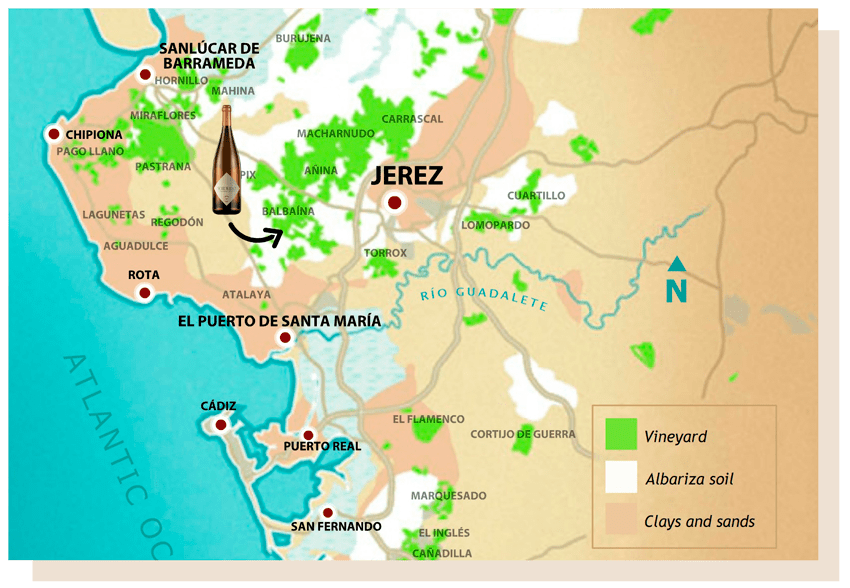Terroir
This part of Andalusia is characterised by the magnificent white albariza soils specific to the Jerez region, the extraordinary adaptation of the palomino grape to these soil and climatic characteristics, and the optimal humidity and temperature conditions prevalent within the local cellars. Together, these factors determine the particular type of flor that develops in each wine and greatly influence its taste.
This remarkable occurrence, unique to the wines from this Atlantic enclave of Andalusia, is allowing us to develop elegant and smooth wines with distinct notes.
Our grapes all come from the iconic Balbaina vineyards between Jerez, El Puerto de Santa Maria and Sanlucar de Barrameda, on Spain’s Southern Atlantic coast.

What is special about this area?
60 million years ago this area was an ocean.
And why is that relevant?
Today, this area is characterised by a white calcareous soil called albariza.
The albariza is a marl – soft rock formed by sediments – with remains of diatoms, unicellular microscopic algae whose cell wall is formed by a shell of silicon
During millions of years these diatoms reproduced, died and fell to the bottom of the ocean, settling layer upon layer. A big part of this albariza soil is made up of these diatoms.
The peculiarity of these silicon shells is that they are like small hollow and perforated boxes, making very fine, porous particles that form a remarkably light and very low density soil dense in minerals.
This porosity and lightness is critical for the root system of the vine, because it allows them to reach water, sometimes even exceeding 10 meters in depth.
Because of its porosity, the albariza structure also acts like a sponge; storing humidity and absorbing excess water, while maintaining the flow of air into the soil. This characteristic is fundamental to the sustainability of the vines, especially during dry season and years with very low precipitation common in South Andalusia.
In such a hot area, the wind is another key factor in the development of the vines. Depending on where it blows from, it brings humidity or dryness.
The area receives a cool and humid wind from the Atlantic ocean, the Poniente, a notable advantage for the grapes from Balbaina. At other times a hot and dry wind blows across the whole region from northern Africa, the Levante.
Palomino Grape
Brilliantly adapted to flourish within these extremes, the Palomino grape has become the dominant varietal. Palomino is a native white grape variety from the South of Spain, highly resistant to drought and able to survive in adverse conditions, accounting for around 95% of the grapes grown in the region.
It is known by 143 different names, the most common being Listan. In other parts of Spain it is simply called Jerez, in the Alentejo region in Portugal it is known as Perrun, in South Africa as Fransdruif, and in Madeira they call it Listrão.
The vine has dark-green leaves and tends to grow horizontally, with large bunches of yellowish green and thin-skinned berries. The grapes, which ripen in August, are juicy, fragile and moderately sweet.
It is characterized by producing medium aromatic intensity juice, with a neutral, balanced and fine structure that makes it especially suitable for subsequent aging beneath the veil of flor.
Sotovelo is made with the finest grapes from one of the most premium organic vineyards in El Puerto de Santa Maria, in the “Pago Balbaina”.
The Harvest
The Palomino grape fully ripens in mid to late August. Seeking shade from the strong Andalusian summer heat, grapes are picked from 4am to 12 midday.
Harvest is done manually, allowing us to choose each bunch, and placed in small 15 kgs boxes, to reach the winery in perfect conditions.